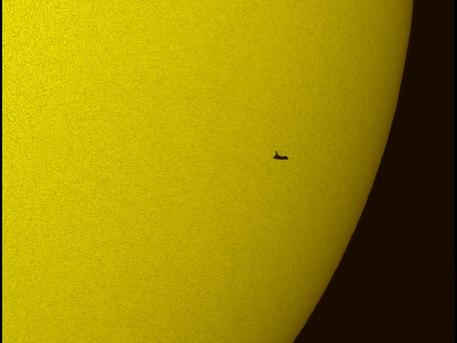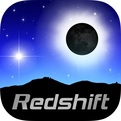Service mission successful so far
Last servicing of Hubble under way
 © NASA/Thierry Legault |
In this tightly cropped image, the NASA space shuttle Atlantis is seen in silhouette during solar transit, Tuesday, May 12, 2009, from Florida. This image was made before Atlantis and the crew of STS-125 had grappled the Hubble Space Telescope.
- » 1 - Mission Overview
- » 2 - Rejuvenating Hubble
Mission Overview
Hubble's triumphs continue to accumulate thanks to a unique design that allows astronauts to repair and upgrade the telescope while it remains in orbit. Repairs keep the telescope functioning smoothly, while upgrades to the instruments bring a slew of new discoveries and science.
The current mission, Servicing Mission 4 (SM4), is the final trip to the Hubble Telescope. Over the course of five spacewalks, astronauts are installing two new instruments, repair two inactive ones, and perform the component replacements that will keep the telescope functioning at least into 2014. The effort-intensive, rigorously researched, exhaustively tested mission also involves diverse groups of people on the ground throughout the country.
The Servicing Mission started on May 11, with the successful launch of the space shuttle Atlantis from the Kennedy Space Center. Today STIS' electronics card was successfully installed and the new cover mounted. Also during the fourth spacewalk the focus was to continue repairs and make improvements that will extend the Hubble Space Telescope’s life into the next decade.
The mission's planning is years in the making, and its success will be the product of months of intensive preparation and the work of hundreds of people at NASA and in academia and industry.
When the astronauts have finished all of their tasks, they will use the robotic arm again to release the telescope, and Goddard will issue the commands to bring the telescope back into operation. But before Hubble's science mission can resume, the telescope will undergo a several-month-long testing and calibrating period. The first new images from the telescope will be released in mid-2009.
Service mission successful so far
Last servicing of Hubble under way
 © NASA/Thierry Legault |
In this tightly cropped image, the NASA space shuttle Atlantis is seen in silhouette during solar transit, Tuesday, May 12, 2009, from Florida. This image was made before Atlantis and the crew of STS-125 had grappled the Hubble Space Telescope.
- » 1 - Mission Overview
- » 2 - Rejuvenating Hubble
Mission Overview
Hubble's triumphs continue to accumulate thanks to a unique design that allows astronauts to repair and upgrade the telescope while it remains in orbit. Repairs keep the telescope functioning smoothly, while upgrades to the instruments bring a slew of new discoveries and science.
The current mission, Servicing Mission 4 (SM4), is the final trip to the Hubble Telescope. Over the course of five spacewalks, astronauts are installing two new instruments, repair two inactive ones, and perform the component replacements that will keep the telescope functioning at least into 2014. The effort-intensive, rigorously researched, exhaustively tested mission also involves diverse groups of people on the ground throughout the country.
The Servicing Mission started on May 11, with the successful launch of the space shuttle Atlantis from the Kennedy Space Center. Today STIS' electronics card was successfully installed and the new cover mounted. Also during the fourth spacewalk the focus was to continue repairs and make improvements that will extend the Hubble Space Telescope’s life into the next decade.
The mission's planning is years in the making, and its success will be the product of months of intensive preparation and the work of hundreds of people at NASA and in academia and industry.
When the astronauts have finished all of their tasks, they will use the robotic arm again to release the telescope, and Goddard will issue the commands to bring the telescope back into operation. But before Hubble's science mission can resume, the telescope will undergo a several-month-long testing and calibrating period. The first new images from the telescope will be released in mid-2009.





